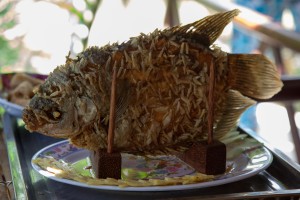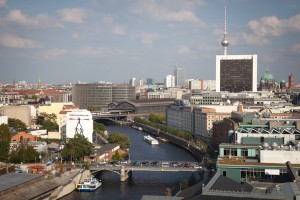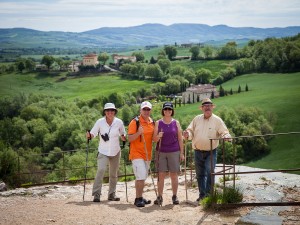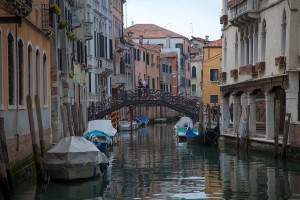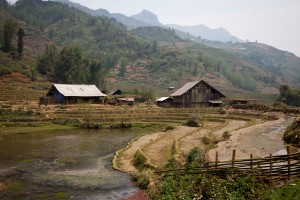 With just ten days left in our round the world trip, we wanted our final days in Vietnam to be memorable and special. To that end, using Hanoi as our home base, we planned a trip to Sa Pa in the north, close to the border with China where we would go trekking for several days in the Hoang Lien Son range of mountains. After that, we planned a three day, two night cruise in Halong Bay, another UNESCO World Heritage Site, renowned for its natural beauty.
With just ten days left in our round the world trip, we wanted our final days in Vietnam to be memorable and special. To that end, using Hanoi as our home base, we planned a trip to Sa Pa in the north, close to the border with China where we would go trekking for several days in the Hoang Lien Son range of mountains. After that, we planned a three day, two night cruise in Halong Bay, another UNESCO World Heritage Site, renowned for its natural beauty.  We arrived in Hanoi via an overnight train from Hue. It wasn’t the best train but it was the only train (S21) with available berths on the day we wanted to travel. The soft sleeper had a pair of bunk beds, the top two bunks were ours for the night. Below were two Vietnamese men, one with a young child. In true Asian style, the mattresses were hard as rock, and quite narrow. There was plenty of space at the end of our bunks to securely store all our luggage. Each bed was equipped with a personal reading light that actually worked, a pillow and a comforter. I was grateful for the silk sleeping bag liners we bought at the last minute in Hue (only $5 US each) as the cleanliness of the bedding was questionable. The whole train was old, grungy and dirty, so why would the bedding be any different? Once we organized our stuff, we fell asleep almost immediately, lulled by the gentle rocking and swaying of the train. It was far more comfortable than I expected, even more comfortable than some guest houses we have stayed in recently. We awoke feeling quite refreshed, much to our surprise. Breakfast consisted of tea purchased from the refreshment cart, and Ritz crackers and M&M candies that we had purchased the day before. Nutrition goes to pot when travelling!
We arrived in Hanoi via an overnight train from Hue. It wasn’t the best train but it was the only train (S21) with available berths on the day we wanted to travel. The soft sleeper had a pair of bunk beds, the top two bunks were ours for the night. Below were two Vietnamese men, one with a young child. In true Asian style, the mattresses were hard as rock, and quite narrow. There was plenty of space at the end of our bunks to securely store all our luggage. Each bed was equipped with a personal reading light that actually worked, a pillow and a comforter. I was grateful for the silk sleeping bag liners we bought at the last minute in Hue (only $5 US each) as the cleanliness of the bedding was questionable. The whole train was old, grungy and dirty, so why would the bedding be any different? Once we organized our stuff, we fell asleep almost immediately, lulled by the gentle rocking and swaying of the train. It was far more comfortable than I expected, even more comfortable than some guest houses we have stayed in recently. We awoke feeling quite refreshed, much to our surprise. Breakfast consisted of tea purchased from the refreshment cart, and Ritz crackers and M&M candies that we had purchased the day before. Nutrition goes to pot when travelling!
 Beautiful scenery on the train from Hue to Hanoi.
Beautiful scenery on the train from Hue to Hanoi.
 Our hotel in Hanoi was located on the edge of the old quarter which consists of about 36 streets which formed the original city at the turn of the 20th century. Back then, each street had merchants and households specialized in a particular trade, such as silk traders, jewellery, etc. The street names nowadays still reflect these specializations. Even today, you will find a street full of foot wear, another street with only eye glass shops, and another dedicated to jewellery. The area is famous for its small artisans and merchants, including many silk shops. There are several attractions in Hanoi but we spent our two days wandering around the old quarter, poking in and out of the shops with no interest whatsoever to venture further afield.
Our hotel in Hanoi was located on the edge of the old quarter which consists of about 36 streets which formed the original city at the turn of the 20th century. Back then, each street had merchants and households specialized in a particular trade, such as silk traders, jewellery, etc. The street names nowadays still reflect these specializations. Even today, you will find a street full of foot wear, another street with only eye glass shops, and another dedicated to jewellery. The area is famous for its small artisans and merchants, including many silk shops. There are several attractions in Hanoi but we spent our two days wandering around the old quarter, poking in and out of the shops with no interest whatsoever to venture further afield.
 What’s for dinner? After placing our selections in the red basket (chicken skewers, large shrimp, ribs, veggie skewers, and morning glory) it was grilled for us and then served on a hot plate in the middle of our table. We sat on miniature plastic stools at a tiny plastic table, in the middle of the sidewalk – very typical for Vietnam. The food was delicious!
What’s for dinner? After placing our selections in the red basket (chicken skewers, large shrimp, ribs, veggie skewers, and morning glory) it was grilled for us and then served on a hot plate in the middle of our table. We sat on miniature plastic stools at a tiny plastic table, in the middle of the sidewalk – very typical for Vietnam. The food was delicious!
 Typical street scenes. It was very common for people to set up temporary stalls along the side walks – maybe a stove and a soup pot with a couple of plastic tables and stools, a pharmacy, or a convenience store.
Typical street scenes. It was very common for people to set up temporary stalls along the side walks – maybe a stove and a soup pot with a couple of plastic tables and stools, a pharmacy, or a convenience store.


 After just one night in Hanoi, we headed north to Sa Pa via another overnight train. Unrealistic expectations can be the death of you and this was a good case in point. Our hotel arranged tickets on a specially designated tourist train which according to the train’s website promised a luxurious trip to Sa Pa. Words cannot describe the disappointment we felt when we entered our compartment with beds that were smaller than the train from Hue, the train itself was dirtier and far less comfortable. And we were on the top bunks again, but this time shared our berth with a very nice young couple from Singapore who we spent some time getting to know and with whom we shared a lot of laughs. In spite of the disappointing train, we ended up having a lot of fun anyways, although we barely slept at all that night and arrived in Sa Pa feeling quite wrecked.
After just one night in Hanoi, we headed north to Sa Pa via another overnight train. Unrealistic expectations can be the death of you and this was a good case in point. Our hotel arranged tickets on a specially designated tourist train which according to the train’s website promised a luxurious trip to Sa Pa. Words cannot describe the disappointment we felt when we entered our compartment with beds that were smaller than the train from Hue, the train itself was dirtier and far less comfortable. And we were on the top bunks again, but this time shared our berth with a very nice young couple from Singapore who we spent some time getting to know and with whom we shared a lot of laughs. In spite of the disappointing train, we ended up having a lot of fun anyways, although we barely slept at all that night and arrived in Sa Pa feeling quite wrecked.  In what has become an unfortunate pattern lately, our pre-arranged transportation to our hotel was nowhere to be seen so we arranged transportation with one of the many mini vans available just outside the station. We happened to share the same mini bus as a young American family we had just met the day before in Hanoi. Funny how we run into the same people sometimes. The train actually arrives in Lao Cai and its about a 45 minute drive to Sa Pa on a winding, twisting road through the mountains that offer spectacular scenery, if the weather permits. Unfortunately, it was very misty and foggy during our drive to Sa Pa and we didn’t see a thing. The weather was much clearer on the trip back affording us some pretty incredible views.
In what has become an unfortunate pattern lately, our pre-arranged transportation to our hotel was nowhere to be seen so we arranged transportation with one of the many mini vans available just outside the station. We happened to share the same mini bus as a young American family we had just met the day before in Hanoi. Funny how we run into the same people sometimes. The train actually arrives in Lao Cai and its about a 45 minute drive to Sa Pa on a winding, twisting road through the mountains that offer spectacular scenery, if the weather permits. Unfortunately, it was very misty and foggy during our drive to Sa Pa and we didn’t see a thing. The weather was much clearer on the trip back affording us some pretty incredible views.  It was almost noon when we finally checked into our hotel room, and we were feeling wiped. After a very long afternoon nap, we went for a brief walk around town before dinner. The town was quite charming in a touristy sort of way. Indigenous women in their native costumes badgered the tourists with their hand made crafts. Apparently this was the place to buy supposedly brand name trekking supplies and Northface products were advertised boldly in every shop. Most of these items were obvious knock-offs – crooked seams, messy stitching on the logo, spelling mistakes in the labels.
It was almost noon when we finally checked into our hotel room, and we were feeling wiped. After a very long afternoon nap, we went for a brief walk around town before dinner. The town was quite charming in a touristy sort of way. Indigenous women in their native costumes badgered the tourists with their hand made crafts. Apparently this was the place to buy supposedly brand name trekking supplies and Northface products were advertised boldly in every shop. Most of these items were obvious knock-offs – crooked seams, messy stitching on the logo, spelling mistakes in the labels.
It was pretty much a waste of a day, but we still had four full days ahead of us to explore the area. We hadn’t booked any trekking tours in advance, figuring we would sort that out on arrival. Turns out that was a very wise decision as the next morning, I awoke feeling so sick with flu-like symptoms: fever, chills, sweats, extreme fatigue. I proceeded to sleep on and off for the next 48 hours. Chris was pretty worried about me, convinced I was fighting some exotic disease like Malaria or Dengue Fever. I was too sick to notice or care, I just wanted to sleep. 

 During this time, Chris didn’t venture too far beyond the town, preferring to stay close to me rather than abandon me in pursuit of his own interests. I don’t think he minded the down time too much as we have been travelling at a quicker pace these past few weeks. I was pretty annoyed that I was sick because I had been really looking forward to some good trekking in the mountains.
During this time, Chris didn’t venture too far beyond the town, preferring to stay close to me rather than abandon me in pursuit of his own interests. I don’t think he minded the down time too much as we have been travelling at a quicker pace these past few weeks. I was pretty annoyed that I was sick because I had been really looking forward to some good trekking in the mountains.  On the third day, I managed to venture out onto our patio for a short while to enjoy the stunning view of the mountains and valleys below. On our last day, I had no choice but to get out of bed as we had to check out and we were again travelling overnight by train back to Hanoi. I did manage to walk down into a small village, but we hired moto taxis to take us back up the mountain as I was still feeling pretty weak and light headed. So much for our grand tour of Sa Pa!
On the third day, I managed to venture out onto our patio for a short while to enjoy the stunning view of the mountains and valleys below. On our last day, I had no choice but to get out of bed as we had to check out and we were again travelling overnight by train back to Hanoi. I did manage to walk down into a small village, but we hired moto taxis to take us back up the mountain as I was still feeling pretty weak and light headed. So much for our grand tour of Sa Pa!  By the time we headed out to our Halong Bay cruise a couple of days later, I was feeling much better. Unfortunately, Chris came down with a serious case of gastro that knocked him right off his feet for the first day and a half of the cruise. What a pair we are! Just as Chris nursed me during my illness, I reciprocated and took care of him even though I was still weak and coughing so much that I feared I had pneumonia. We were quite the sickly pair. On the second day, we both forced ourselves to go kayaking to try to enjoy some of the spectacular scenery in Halong Bay. By then the worse had passed for both of us and we did our best to enjoy the rest of the cruise. On our final day, we visited some impressive caves before heading back to Halong City.
By the time we headed out to our Halong Bay cruise a couple of days later, I was feeling much better. Unfortunately, Chris came down with a serious case of gastro that knocked him right off his feet for the first day and a half of the cruise. What a pair we are! Just as Chris nursed me during my illness, I reciprocated and took care of him even though I was still weak and coughing so much that I feared I had pneumonia. We were quite the sickly pair. On the second day, we both forced ourselves to go kayaking to try to enjoy some of the spectacular scenery in Halong Bay. By then the worse had passed for both of us and we did our best to enjoy the rest of the cruise. On our final day, we visited some impressive caves before heading back to Halong City. 


 There were many small boats like this one that sold everything imaginable – a convenience store on the bay. I was gouged when I bought a small box of Ritz crackers for Chris for $5 US – I didn’t even think to haggle, I was just too preoccupied with getting something that Chris could eat.
There were many small boats like this one that sold everything imaginable – a convenience store on the bay. I was gouged when I bought a small box of Ritz crackers for Chris for $5 US – I didn’t even think to haggle, I was just too preoccupied with getting something that Chris could eat.
The dining room – the food was top notch on this trip.
 We came across this little fellow as we left one of the caves on our final morning in Halong Bay. Chris couldn’t resist one last monkey shot.
We came across this little fellow as we left one of the caves on our final morning in Halong Bay. Chris couldn’t resist one last monkey shot.
We spent our final night back in Hanoi. Neither of us felt like going out on the town one last time. We were in a reflective mood, trying to absorb the fact that our trip was coming to an end. It seemed quite unreal to us that we would be in Canada the next day. True to form, I was beginning to feel some excitement about our return home, accepting that this wonderful chapter in our lives was closing, but feeling very optimistic for what lay ahead. I was quite certain another adventure awaited us.
Travel tip #1: We switched hotels in Hanoi after our first night because the original hotel was closing down. We stayed at the Artisan Boutique Hotel for 2 nights (one before and one after our cruise) and would highly recommend this hotel. It is located in the heart of the Old Quarter just a block away from the lake. This small, boutique hotel offers very clean, comfortable, spacious rooms with great service to match. On the first night, we arrived at 5:00 am after our overnight train from Sa Pa and we were offered a room immediately at no extra charge (deluxe room at $45 US per night). When we returned from our cruise, our standard room ($30 US per night) was upgraded to the deluxe room at no extra charge. Private transportation to the airport was also arranged for $15 US.
Travel tip #2: The number of cruise operators in Halong Bay is dizzying. First of all, we highly recommend you book a 3 day/2 night cruise as opposed to the 2 day/1 night option. It is only on the second day that you really start exploring the bay, getting away from the crowds from the first day. We booked our cruise with V’Spirt Cruises and found the best price through Agoda ($188 US per person before tax). Not exactly 5* luxury, the boat is very clean and comfortable, the itinerary is excellent, and the food outstanding. We would highly recommend this cruise.







